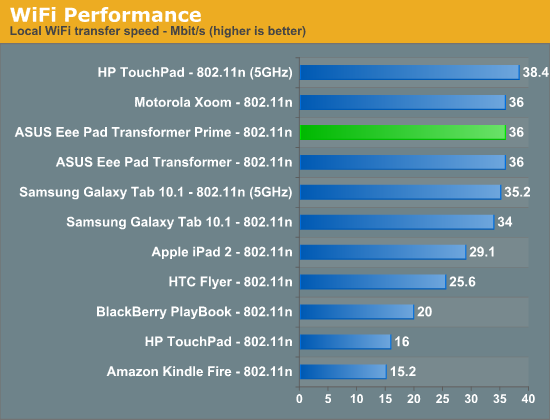Scaling to 802.11ac Speeds in Smartphones and Tablets
by Anand Lal Shimpi on January 5, 2012 8:00 AM EST- Posted in
- Smartphones
- Mobile
- 802.11ac
- HSIC
- Tablets
I promise this is the last thing I'll write about 802.11ac today, but it is very relevant to our smartphone and tablet coverage. If you've followed any of our reviews in the mobile space you'll notice that there seems to be a bit of a glass ceiling in terms of WiFi performance on smartphones and tablets:

We have yet to see a device that can download consistently at more than 36Mbps. For most smartphones/tablets this isn't alarming as they only support 2.4GHz 802.11n and a single spatial stream, resulting in a maximum interface speed of 72Mbps. Factor in loss and overhead and you're left with about half that as real world performance.
It turns out, as you'd expect, that there's another bottleneck in these devices limiting their peak WiFi performance: the SDIO interface and it's associated drivers.
SDIO is an I/O interface based on the Secure Digital (SD) standard. This is the same standard that is used for removable flash storage in cameras. The SDIO interface itself is capable of a maximum bandwidth of 100Mbps. It turns out that the SDIO software stack can further limit the interface's performance to the 30 - 40Mbps range. The appeal of rewriting SDIO drivers for Android likely contributes to continued propagation of this issue.
One solution to this problem is a transition to a more modern interface: HSIC. HSIC (High-Speed Inter-Chip) is a serial USB based interface that is destined to replace SDIO. Whereas today SDIO based WiFi solutions are offered to phone and tablet vendors, with 802.11ac we'll see both SDIO and HSIC versions. HSIC should guarantee speeds of up to 480Mbps (theoretical).
The HSIC software stack is also apparently more robust and isn't expected to pose a problem in the way that SDIO has thus far. Given that smartphones and tablets are expected to use single stream 802.11ac at 433Mbps, HSIC looks to be the appropriate SoC interface.
It remains to be seen how fast 802.11ac will be in practice. But if all goes well, I wouldn't be too surprised to see at least 100Mbps over 802.11ac WiFi on a smartphone in the next two years. If we're lucky, we may even get 2 - 3x that.










15 Comments
View All Comments
freefx - Thursday, January 5, 2012 - link
Anand,I'm interested to know where you got the SDIO interface speeds from, but SDIO spec 2.00 (which is used by several vendor's current mobile wireless solutions) supports High Speed 4-bit SD Mode at 50MHz (200Mbps). The current SDIO spec 3.00 adds support for UHS-I which allows for 208MHz in 4-bit SD mode giving you 832Mbps theoretical maximum throughput.
I also find it difficult to believe (if i'm reading you correctly), the everyone from Apple to Microsoft uses the same SDIO "software stack". The SDIO interface if fairly hardware dependent, and any drivers written for it will depend on the device's operating system and host processor vendor. SDIO is also fairly simple and rewriting a driver for SDIO isn't that complicated and is just an extension of the standard SD interface to add an interrupt and some IO specific registers.
I would imagine a larger bottleneck is in how much processor time is being given to the wlan driver that uses the SDIO interface and the RF chip itself. Trying to pump through a massive amount of data and managing the wlan connection uses a good bit of processing power, and you don't want to make your device sluggish just to push through 65Mbps, which is the typical theoretical max of the wlan mobile chipsets RF radios anyway (when using a single 802.11n channel).
Your articles are usually pretty good, I just don't agree with your assessment of SDIO being a limitation, and board level USB being a better replacement.
Anand Lal Shimpi - Thursday, January 5, 2012 - link
The issue as I've seen depends on the SoC and the WiFi controller. Older SoCs still implement SDIO 1.0, while the WiFi chips a lot of devices use are SIDO 1.2 compliant. Best case scenario for SDIO 1.2 appears to be 196Mbps, but it looks like there are other limitations in the chain there as well. Newer SoCs implement SDIO 2.0 (and HSIC) but I don't know that many of the WiFi devices are up to that point yet.I believe we are going to see 802.11ac based solutions using both SDIO and HSIC going forward. It would make sense that they would implement higher bandwidth versions of SDIO as well for those customers who choose to use it.
Take care,
Anand
Yuniverse - Thursday, January 5, 2012 - link
Just curious, but have you tried the speed of the wifi on iPad 2 with 5GHz? I don't see it on the chart and when I test my speed with speedtest.net app, it consistently gives me 38.xxx Mbps down/ 21Mbps up. Kind of like the Touchpad on 5GHz you have up there.name99 - Thursday, January 5, 2012 - link
Anand stated in an earlier article that all modern Apple kit uses Broadcomm chips, and these chips, when talking to each other, can use some of the optional features of the n spec to improve performance.In other words, if you use an iPad2 with a recent Airport Base Station, you may well get 10-15% better performance than if you use that same iPad2 with some other random base station which does not use a Broadcomm chip.
shabby - Thursday, January 5, 2012 - link
Customer: Wow that phone is 5g?!?Sales Rep: Yes it is... <says silently> the wifi portion at least
Customer: So its faster than my 4g phone?
Sales Rep: Of course... <says silently> the wifi portion at least
Customer: shut up and take my money!